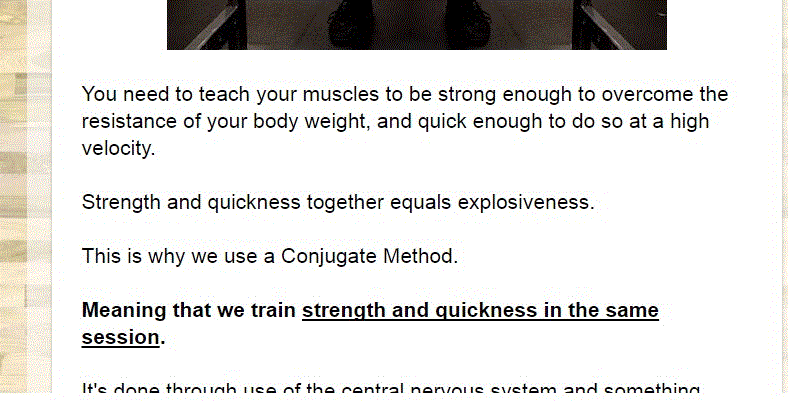
This is an excerpt from a well known vertical jump internet expert. Talking about how they use the “conjugate method” of training by implementing both “explosive” and “strength” exercises in the same session.
There is only one problem with this post: it’s not even close to the actual conjugate method of training.
Here is a little background on the conjugate method. This is an excerpt from “Principles and Practice of Resistance Training”[1] written by Dr. Stone and one of the best (IMO) strength and conditioning books ever written.
“Basically the conjugate system is an intermesocycle variation strategy that involves periods of accumulation followed by restitution and recovery during which superior adaptations can be exploited. This is achieved through a series of concentrated blocks that are up to four weeks in duration. For example, during the first block, a strength-power athlete interested in maximizing power and speed would perform high volume loads of work with one primary emphasis (e.g., strength or strength-endurance, with minimal loads allocated to other abilities designed as maintenance work). The objective is to saturate the system with one type of stress over a period of several weeks.”
Here is another example, an excerpt from Jay Hoffman’s NSCA program design, “The conjugated sequencing model, or coupled successive system, as it was originally termed (64, 83), is a system for sequencing and integrating training factors typically employed with advanced athletes (41, 44, 64, 69, 71, 74, 78, 80, 86, 88). Central to this model is the sequencing of accumulation (64, 81, 84) (concentrated loading) (64, 80), transmutation (43, 44, 88), and realization (43, 44) or recovery (64, 80) mesocycles in order to take advantage of residual (delayed) training effects”
What does all this mean?
- The conjugate method is also known as “block periodization”. It is an annual training plan where an athlete essentially trains all out for one motor ability, and then switches to a different motor ability. This is the style of training I use for my elite level athlete program (although tweaked into a multi-targeted block approach).
- It is a training plan, NOT a method of working out and certainly NOT when you perform a heavy resistance exercise and follow it up with an explosive exercise.
Moving on…..
When you perform a heavy exercise followed by an explosive exercise this is termed complex training or contrast training. It attempts to utilize a thing called post-activation potentiation, which is a theory which in laymen’s terms means by performing the heavy exercise it improves your neuromuscular systems ability to contract on the lighter explosive exercise.
There is a few problems with this style of training:
- There is no consensus as to the proper protocol (how to use it, rest after the heavy set, how much, which exercise etc.)
- Compound training (training in separate sessions) appears more effective for jumping
A 2015 study published by the Journal of Strength and Conditioning Research found after 6 weeks of complex vs compound training, “Jumping (4 +/- 3%) and throwing (9 +/- 8%) performance increased only with compound training (P < 0.02). Bench press (5% vs. 18%), leg press (17% vs. 28%) and Smith machine box squat (27% vs. 35%) strength increased after both compound and complex training.”
And the great thing about this study was that training volume was equal (although you know I am a bigger fan of tracking volume-load if you have my guide to developing the vertical jump ) As long as the subjects did not overly fatigue it appears the volume-loads would be equated.
This is one of the reasons I use a compound style of training in my beginners program.
In summary, I am certainly not perfect and get things wrong (more often than I’d like to admit), but if your using fancy words like “conjugate” in an attempt to sell a product, at least double check you’re using the right terminology.
- Stone, Michael H., Meg Stone, and Bill Sands. Principles and Practice of Resistance Training. Champaign, IL: Human Kinetics, 2007. Print
- Hoffman, Jay (2011-12-13). NSCA’s Guide to Program Design (Science of Strength and Conditioning) (Kindle Locations 4895-4898). Human Kinetics. Kindle Edition.
- Stasinaki, Angeliki-Nikoletta, Giorgos Gloumis, Konstantinos Spengos, Anthony J. Blazevich, Nikolaos Zaras, Giorgos Georgiadis, Giorgos Karampatsos, and Gerasimos Terzis. “Muscle Strength, Power, and Morphologic Adaptations After 6 Weeks of Compound vs. Complex Training in Healthy Men.” Journal of Strength and Conditioning Research29.9 (2015): 2559-569. NSCA. Full text here: http://journals.lww.com/nsca-jscr/Fulltext/2015/09000/Muscle_Strength,_Power,_and_Morphologic.22.aspx
